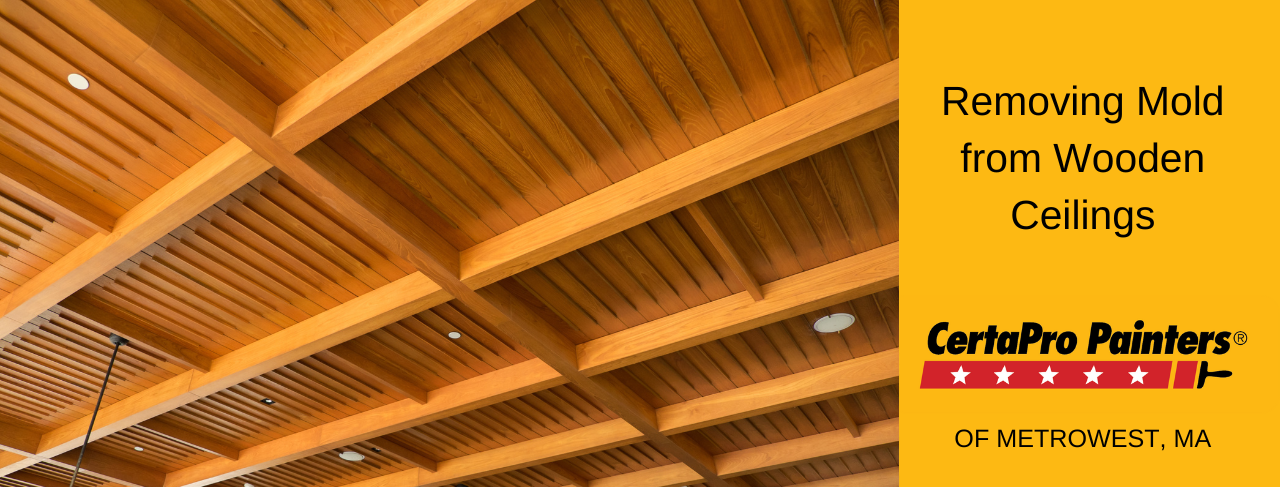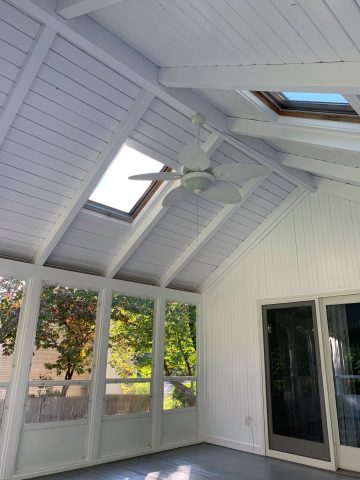
Removing Mold from Wooden Ceilings
Posted on May 2, 2023
Mold is a common problem in many households, especially in areas with high humidity levels. Wooden ceilings are susceptible to mold growth because of their porous nature and tendency to absorb moisture – especially when the wood is untreated or unfinished. Moldy ceilings are particularly common with enclosed porches, where the home’s climate control isn’t helping to manage temperature and humidity.
 A ceiling with mold is an eyesore, of course, but it can cause respiratory problems and other health issues. To identify mold on the ceiling, there are several signs to look for. The most obvious is visible mold growth, which can appear as black or green spots or a fuzzy, discolored patch. You may also notice a musty odor, especially in areas that are poorly ventilated. If you see water stains or discoloration on your ceiling, this could also be an indication of mold growth.
A ceiling with mold is an eyesore, of course, but it can cause respiratory problems and other health issues. To identify mold on the ceiling, there are several signs to look for. The most obvious is visible mold growth, which can appear as black or green spots or a fuzzy, discolored patch. You may also notice a musty odor, especially in areas that are poorly ventilated. If you see water stains or discoloration on your ceiling, this could also be an indication of mold growth.
Before you get started, it’s important to identify the extent of the problem. If the spots and other signs are minimal, you’ve caught the mold growth early, and taking care of the problem is relatively easy! If the mold is widespread, covering an area of more than 10 square feet, or if the problem has persisted for a long time, it might be necessary to call a professional mold removal surface.
If the issue seems manageable, though, these steps will help you remove the unsightly mold from your wooden ceiling.
Step 1: Safety First
Before you begin removing mold from your wooden ceiling, it is essential to take the necessary safety precautions. Mold spores can be harmful when inhaled, so be sure to wear protective gloves, a mask or respirator, and goggles. Make sure the room is well-ventilated to prevent the spread of mold spores to other areas as well.
Step 2: Prep
First, use a vacuum (ideally with a HEPA filter) to go over the moldy area and collect any loose spores. Take the vacuum outside and empty it into a sealable bag to keep the spores contained.
Next, you’ll need to prepare a cleaning solution. There are several options here, including a mixture of water and vinegar, hydrogen peroxide, or bleach. Keep in mind, however, that bleach can be harmful to wood surfaces, so it’s usually best to start with something less abrasive. In most cases, a solution of equal parts white vinegar and warm water will be plenty effective.
Step 3: Apply the Cleaning Solution
Put your cleaning solution in a spray bottle, and apply it liberally to the affected area. Make sure you cover all visible mold growth. Let the solution to sit for several minutes, allowing it to penetrate the wood and kill the mold spores. Saturation is important for preventing mold spores from getting into the air as well.
Step 4: Scrub
Using a brush or sponge, scrub the affected area, making sure to remove all visible mold growth. Be careful not to scrub too hard or use an overly abrasive brush, or you might cause irreparable damage to the wood surface.
Step 5: Rinse and Dry
After scrubbing the affected area, rinse the wooden ceiling thoroughly with clean water. Use a dry cloth or fan to dry the area, and continue until there is no remaining moisture. Remember that moisture is the main cause of mold growth, so it’s essential to make sure the wooden ceiling is completely dry.
Step 6: Future Prevention
To prevent mold growth from recurring, you’ll have to address the underlying cause of the problem. This may involve fixing any leaks, improving ventilation, or even using a dehumidifier in the affected area.
Moving forward, be sure to periodically check for any signs of returning mold growth. If you see spots forming, repeat the steps above to tackle the problem right away. Even if you don’t see new mold growth, it’s a good idea to include a good ceiling scrub at least once a year as part of your regular home maintenance.
Removing mold from wooden ceilings can be an irritating, time-consuming process, but it’s necessary for sake of both your home and the health of your family. By following these steps and taking the necessary safety precautions, you can effectively remove mold and prevent it from recurring… But if homemade solutions and scrubbing don’t seem to work, or if the affected area is larger than you can handle, you can always turn to the pros!
For questions about mold removal, prep for home projects, interior and exterior painting, and beyond, contact CertaPro today!





